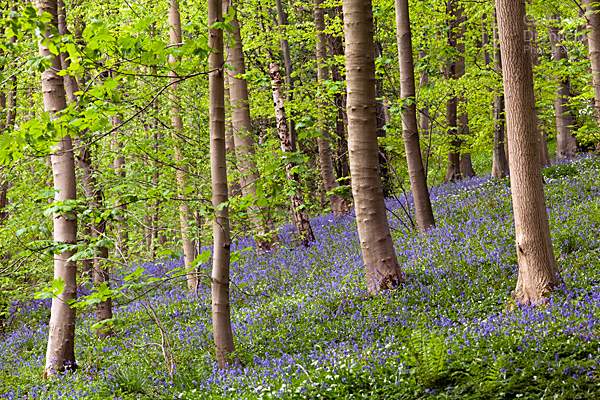Bluebells and ramsons in May
Spring, or more specifically May, is the time nature photographers tend to get very excited about the rich tapestry of bluebells and ramsons (or wild garlic) that carpet the glades of woodlands in the UK. Such woods are typically dominated by beech trees that allow just the right amount of light to reach the woodland floor for these plants to prosper.
Robin Hood’s Howl beech woodland
There are many such woods around the country, some more well known than others. One which really ought to be more popular is Robin Hood’s Howl, a mile long ribbon of beech woodland near Kirkbymoorside in North Yorkshire.
Strictly speaking the woods are just outside the North York Moors National Park boundary. However for the sake of this website I’ll include photos from here in my North York Moors photo gallery. I have been there a number of times over the years, but not in recent times. With this in mind a visit was long overdue.
Its only a short walk west from Kirkbymoorside to reach the southern end of the Howl, or ‘hollow’ (I’m not sure where the ‘Robin Hood’ part of the name comes from). From there access to the woodland is gained by a gate.

Southern entrance into Robin Hoods Howl
Thanks to a predominance of coniferous trees at this end of the howl there are no signs of either bluebells or ramsons at this point but don’t give up. Within a few yards the evergreen trees give way to a deciduous woodland with a thick undergrowth of brambles and grasses.

Brambles in Robin Hoods Howl
Ok, not very impressive and definitely not worth travelling to. However press on further into the wood and, assuming you’re there at the right time of year, you won’t be disappointed. The scenery does improve!
Ramsons in Robin Hood’s Howl
A few yards further on and the woodland is dominated by beech trees with a thick undergrowth of wild garlic. The footpath goes on for about a mile, meandering lazily through the sea of ramsons that populate this shallow, narrow valley.

Footpath through flowering ramsons in Robin Hoods Howl
It is impossible to lose the path and get lost!

Coppicing in Robin Hoods Howl
The stack of wood logs leaning up against the tree is evidence of coppicing, a practice common in such beech woodland.
Sadly the day I visited the Howl was overcast so there was no light to play with. Also, thanks to a storm that hit the area in the winter of 2015/2016, there are plenty of places where trees have fallen across the path and obstructed the way. To get a photo along the path without including any such trees took some effort. Such a shame. Hopefully this will be rectified at some point, if only to make things easier for photographers.
Anyway, there was no time to get emotional about such things as it was time to make do, wander along the path and take some more photos.

Looking back down the footpath

Yet more ramsons along another stretch of footpath
It may look like it but I wasn’t stood on any flowers when taking the of the photos in this article.
With no sunlight, I tried a more detail shot of the path running through the wild garlic. Careful not to damage any flowers I found a small patch of bare ground off the path to stand on and took the following photo. I thought worked quite well as the red of the path contrasted well with the green ramsons.

Footpath through flowering ramsons in Robin Hoods Howl
Bluebells in Robin Hood’s Howl
Throughout Robin Hood’s Howl there are small patches of bluebells that are in flower at the same time of year but they are far outnumbered by wild garlic. There is one sizeable patch near the top of the Howl, at the northern end of the wood. It is quite far off the path though so I couldn’t really get close without trampling over loads of flowers. That was no problem though as I had my zoom lens with me and used it to take the following photo of them.

Footpath through flowering ramsons in Robin Hoods Howl
And thats Robin Hood’s Howl – a hidden gem of a woodland worth a visit at any time of year but definitely in the spring.
Further reading:
Subscribe to my newsletter
To receive an email whenever a new blog entry is published please enter your email address below and it will be added to my list:
Your email address will not be shared.

We were walking yesterday and part of the walk took us through Robin Hoods Howl. I googled to see what a description of Howl meant and came upon your page with lovely photographs. We are looking forward to exploring again in the area.
Yes, it is a lovely area. If you do find out what Robin Hood had to do with this wood please let me know. Meanwhile, enjoy your exploring. Oh, and thanks for the kind words.